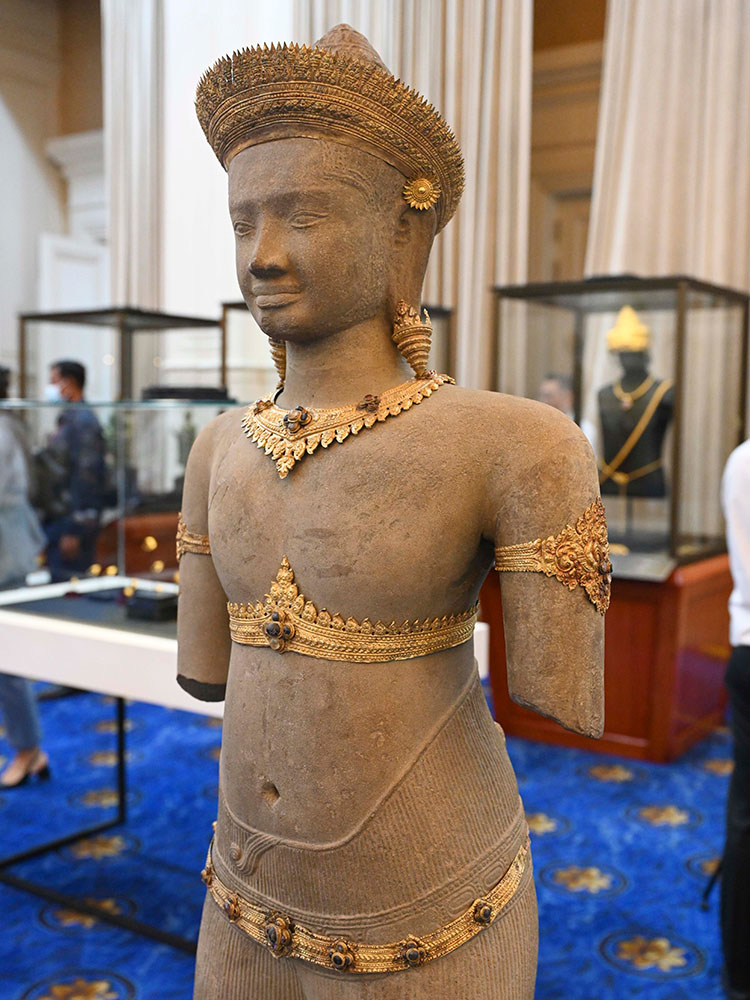Using AI to Identify Plundered Antiquities

A centuries-old looted sandstone statue, repatriated to Cambodia in 2023. BU researchers have created a new database they hope will one day help authorities track down other stolen artifacts. Photo by Kok Ky/Cambodia’s Government Cabinet via AP
Using AI to Identify Plundered Antiquities
BU archaeologists use machine learning algorithm to help identify stolen Cambodian statues
Taking a freshman year class about ancient China, archaeologist Hallie Baker (CAS’25, GRS’25) learned about the sorry history of Western museums and collectors looting Eastern art. “It’s happening now as we speak,” with Cambodia a recent victim, she says. The New York Times reported that foreign museums and private collections stash perhaps 4,000 stolen Cambodian pieces—artifacts dating back a millennium and more—purloined from temples and holy places in the country across generations.
When museums and collectors don’t know, or care, that they’re holding stolen art, recovery is tricky. Dealers in stolen merchandise “are doing everything they can to pass it off as legal,” says Baker, who recently graduated from Boston University’s joint BA/MA in archaeology program. “So they are faking provenance histories, they’re faking documents about where it came from [or] that say it was outside of the country before 1970,” when the UNESCO Convention banned removal of cultural property without legal documentation.

She and Robert Murowchick, a College of Arts & Sciences director of archaeology undergraduate studies and Baker’s thesis adviser, tapped artificial intelligence to aid human detectives hunting for plunder. They’ve created a database, the Khmer Statuary Project (KSP), that uses machine learning algorithms—trained on images from archives, art catalogs, museum databases, and private collections—to automate the identification of potentially stolen Cambodian statues. Baker completed an earlier iteration of the work for BU’s Undergraduate Research Opportunities Program and wrote her thesis on the project. She will spend the next two years in the United Kingdom on a Marshall Scholarship at the University of Cambridge and University College London.
When a user plugs in an image of a statue, the KSP will return 15 possible matches, Baker says. “The user can then confirm if the statue they are looking for already exists in the database with corresponding images and provenance information, or not,” she says. The algorithm “considerably cuts down on the amount of time and human labor needed to make these associations.” Researchers otherwise would have to probe, manually, through potentially hundreds of images to check a statue’s history and ownership.
For now, Baker’s thesis notes, the KSP is a work in progress and not quite ready for use by governments, institutions, or the public: “While the current accuracy of the model is limited by the comparably small size of the dataset (690 images), as more data is added, the performance is expected to exponentially increase. The KSP dataset is therefore designed to be growable in its implementation.” Going forward, Murowchick, who’s also a CAS lecturer of archaeology, will seek additional, crowdsourced photos for the database, to continually train the algorithm and improve its accuracy. (Two undergraduates, Sachiel Chuckrow (CGS’24, CDS’27) and Matthew Frysinger (CDS’26), helped with the project.)
One reason to focus on Cambodian art, Baker says, is because that country’s government “has done amazing work to get museums in the West to repatriate their cultural objects. They’ve done a lot of work identifying pieces that have been looted and then providing evidence that shows they were looted.”
[The Cambodian government] has done amazing work to get museums in the West to repatriate their cultural objects.
Some cultural institutions have tried to be responsible when it comes to looted statues, Murowchick says. New York’s Metropolitan Museum of Art has repatriated several; Boston’s Museum of Fine Arts has been lauded for its research into what might be plunder in its collection and into avoiding stolen objects going forward. But not everyone is so scrupulous.
Murowchick says that a California couple outfitted their $42 million mansion with allegedly stolen Khmer Cambodian statues that were only thrown into the spotlight after the luxury home was featured in Architectural Digest. In the magazine’s glossy photos, “the statues were airbrushed out,” Murowchick says, “but they left the pillars that were holding the statues in the photographs. It didn’t take a genius of a journalist to contact the photographer to get a copy of the original photo” and expose the potential thefts.
As for the dollar value of looted statues, “it’s an unknowable number, but it is tens of thousands,” he says. One purloined item that was recognized and repatriated a decade or so ago had been expected to fetch up to $4 million at a Sotheby’s auction, Murowchick adds.
Baker assigns the bulk of responsibility for unresolved thefts to “Western museums and private collectors, both for willful ignorance of the issue and also lack of awareness around the issues. Looting is not just happening in Cambodia. It’s happening around the world. And so this same solution [the KSP] can be applied to other regions.”
“What is happening increasingly is that they reach a compromise,” Murowchick says. “The museum admits that they got it under less than legal or ethical circumstances; the source country reaches agreement that the museum will recognize it belongs to that nation, but agrees to leave it on long-term loan at the museum. So everybody’s happy.”
Countries at war, where repatriated art might be damaged or destroyed, actually prefer such agreements, he says.

Comments & Discussion
Boston University moderates comments to facilitate an informed, substantive, civil conversation. Abusive, profane, self-promotional, misleading, incoherent or off-topic comments will be rejected. Moderators are staffed during regular business hours (EST) and can only accept comments written in English. Statistics or facts must include a citation or a link to the citation.